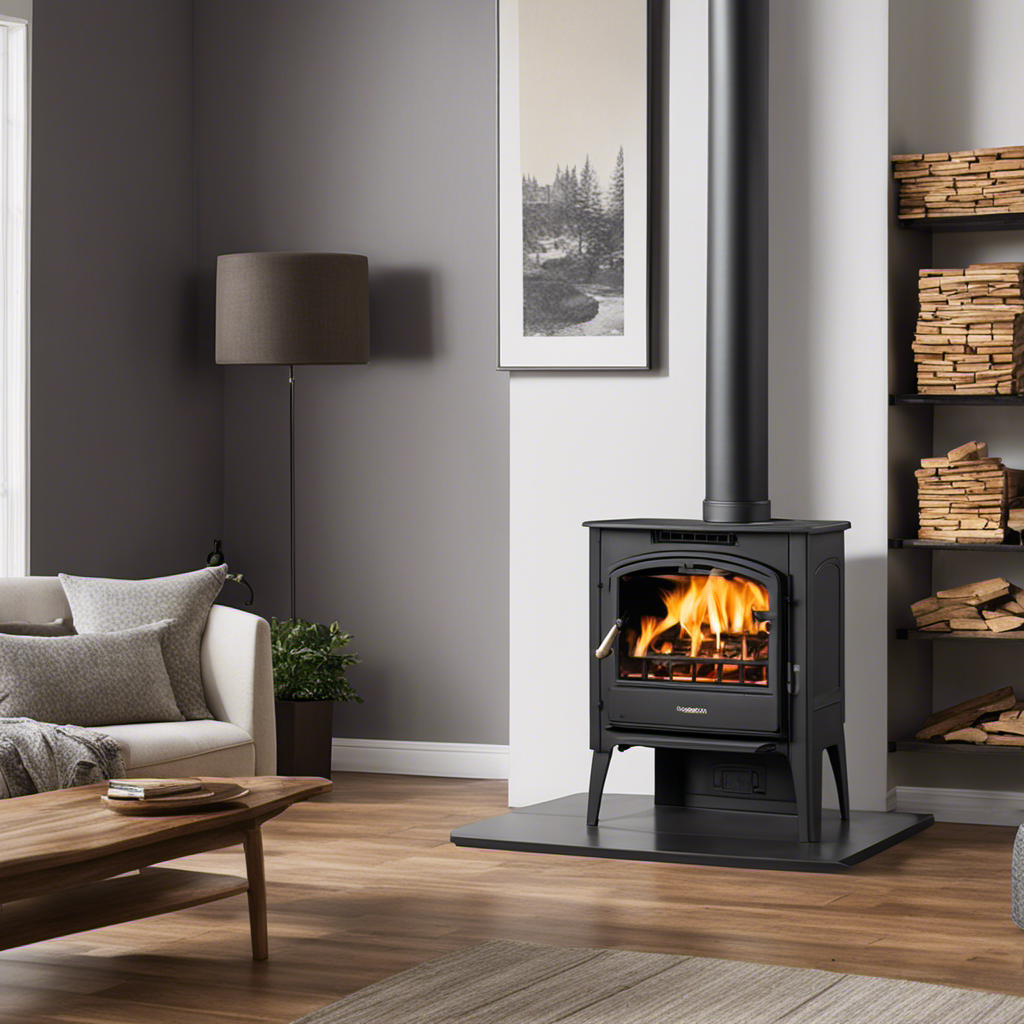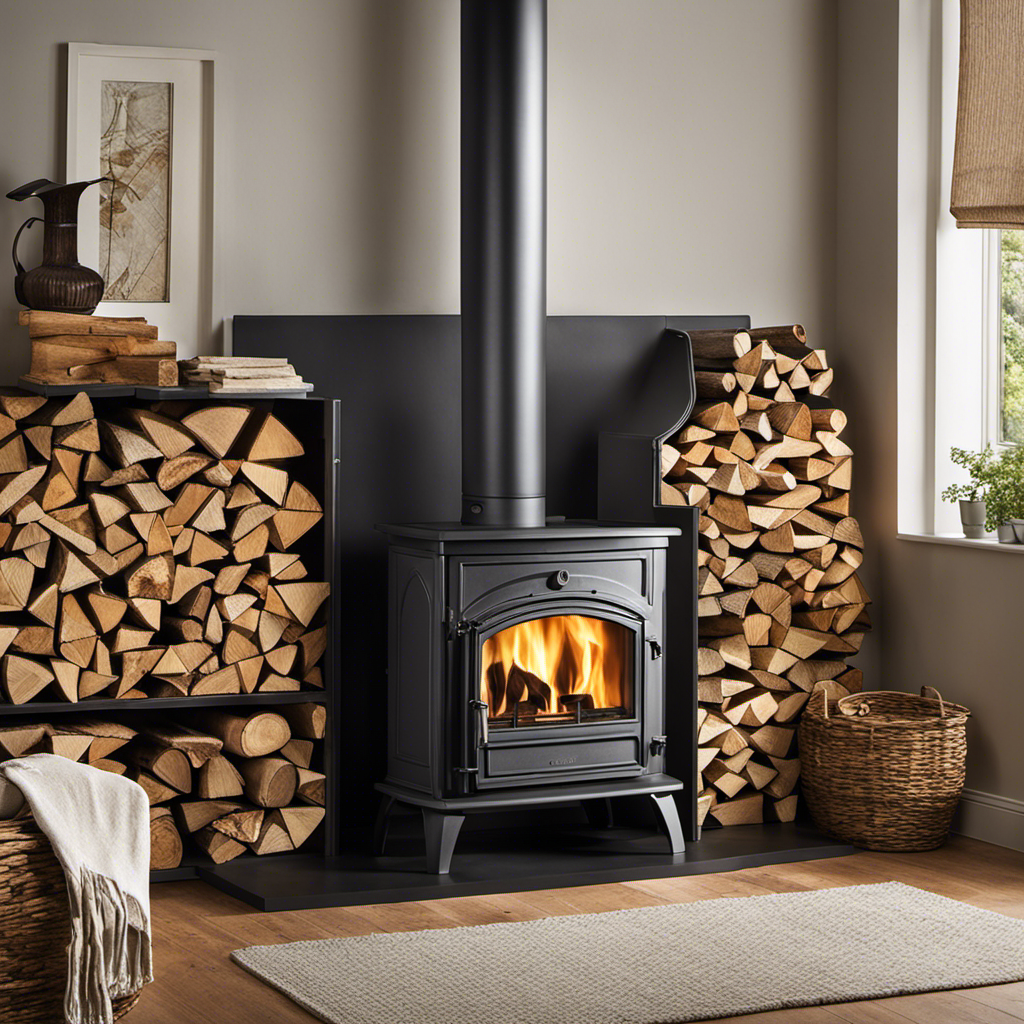The importance of fire safety protocols and the critical need for carbon monoxide detectors when using high-efficiency wood-burning stoves cannot be understated.
Did you know that according to the National Fire Protection Association, heating equipment, including wood stoves, is one of the leading causes of home fires?
In this article, we’ll delve into the crucial role these safety measures play in ensuring the safe operation of high-efficiency wood burning stoves and provide you with essential information to keep your home and loved ones safe.
Key Takeaways
- Regular cleaning and maintenance of wood burning stoves is crucial to prevent home fires and the buildup of creosote.
- Carbon monoxide detectors play a vital role in stove safety by providing early detection of low levels of CO and continuous monitoring for elevated CO levels.
- Proper placement and ventilation of wood burning stoves are essential to prevent fire risk and CO buildup.
- Implementing child safety measures, such as childproofing, establishing boundaries, and educating children about stove dangers, is necessary for a safe environment.
Importance of Fire Safety for High-Efficiency Wood Burning Stoves
We understand the importance of fire safety for high-efficiency wood burning stoves and always ensure we have the necessary precautions in place.
When it comes to fire safety regulations, it is crucial to prevent chimney fires. Chimney fires can occur due to the buildup of creosote, a highly flammable substance that forms when wood burns.
To prevent chimney fires, regular cleaning and inspection of the chimney are essential. We recommend an annual inspection by a certified professional who can identify any potential issues and clean the chimney if necessary.
Additionally, using dry and seasoned wood can minimize creosote buildup. It is also important to follow the manufacturer’s guidelines for stove operation and maintenance.
The Role of Carbon Monoxide Detectors in Stove Safety
To ensure the safety of our household, we rely on carbon monoxide detectors, which play a vital role in monitoring stove emissions and alerting us in case of any potential danger. Carbon monoxide (CO) is a colorless, odorless gas that can be emitted by high-efficiency wood burning stoves.
Here are some benefits of carbon monoxide detectors:
-
Early Detection: Carbon monoxide detectors can detect even low levels of CO in the air, allowing us to take immediate action to prevent any harm.
-
Continuous Monitoring: These detectors work 24/7, providing round-the-clock protection and ensuring our safety at all times.
-
Audible Alarms: When elevated levels of carbon monoxide are detected, the detectors emit loud, distinctive alarms, alerting us to evacuate and seek fresh air.
-
Peace of Mind: With carbon monoxide detectors in place, we can rest easy knowing that we’ve an additional layer of protection against this silent killer.
Safe Operation Practices for High-Efficiency Wood Burning Stoves
How can we ensure the safe operation of our high-efficiency wood burning stove while following proper safety practices?
To ensure safe operation guidelines, regular maintenance and adherence to safety protocols are crucial. First, it’s essential to clean the stove and chimney at least once a year to prevent the buildup of creosote, which can lead to chimney fires. Additionally, proper storage of firewood away from the stove is necessary to avoid the risk of accidental ignition. Furthermore, always use dry, seasoned firewood to minimize the production of harmful pollutants. Regularly inspecting and replacing damaged parts such as gaskets and seals is also important for optimal performance and safety.
By following these maintenance tips and safety guidelines, we can enjoy the warmth and efficiency of our wood burning stove while ensuring the safety of ourselves and our loved ones.
In the subsequent section, we’ll discuss the importance of ensuring proper placement of wood burning stoves for safety.
Ensuring Proper Placement of Wood Burning Stoves for Safety
While considering the safety of wood burning stoves, it’s important to ensure proper placement in order to prevent potential hazards. Proper installation and adherence to clearance requirements are essential for the safe operation of these stoves. Here are some key points to keep in mind:
-
Clearance Requirements: Maintain a safe distance between the stove and combustible materials such as walls, furniture, and curtains. This prevents the risk of fire and ensures proper ventilation.
-
Proper Ventilation: Install the stove in an area with adequate airflow to prevent the buildup of carbon monoxide, a colorless and odorless gas that can be deadly.
-
Protection for Floors: Use non-combustible materials, such as tiles or fire-resistant mats, to protect the floor beneath the stove from heat damage.
-
Proximity to Exits: Place the stove in an easily accessible location, ensuring a clear path to exits in case of emergency.
Child Safety Measures for Wood Burning Stoves
We need to implement child safety measures and closely supervise our children around wood burning stoves to ensure their well-being and prevent any accidents. Childproofing our homes and installing safety gates can significantly reduce the risk of burns and other injuries. It’s vital to keep flammable objects away from the stove and establish a clear boundary around it.
Additionally, teaching children about the dangers associated with wood burning stoves and the importance of not touching or playing near them is crucial. Proper education and constant supervision are key to maintaining a safe environment for our children.
In the subsequent section, we’ll provide a comprehensive guide to safety measures for high-efficiency wood burning stoves, including the importance of fire safety and carbon monoxide detectors.
Comprehensive Guide to Safety Measures for High-Efficiency Wood Burning Stoves
Installing carbon monoxide detectors is essential for ensuring the safety of our homes when using high-efficiency wood burning stoves. These detectors are designed to monitor the levels of carbon monoxide in the air and provide a warning if it reaches dangerous levels.
To guarantee safe installation and operation of these detectors, it’s important to follow the manufacturer’s instructions and place them in strategic locations. Regular maintenance procedures, such as checking the batteries and testing the detectors, should be performed to ensure their effectiveness.
Additional safety measures for wood burning stove owners include:
- Regular chimney cleaning to prevent the build-up of creosote and potential fire hazards.
- Proper ventilation to allow for the efficient burn of wood and minimize the production of harmful gases.
- Safe storage of firewood away from the stove to prevent accidental fires.
- Regular inspection of the stove and its components to identify any signs of wear or damage.
Exploring Other Safety Considerations for Wood Burning Stove Owners
When it comes to wood burning stove safety, there are other important considerations to explore.
Proper ventilation is crucial to ensure the release of harmful gases and prevent the buildup of carbon monoxide.
Additionally, regular maintenance is essential to keep the stove in optimal condition and minimize the risk of fire hazards.
Proper Ventilation for Safety
Let’s ensure adequate airflow in our homes by regularly cleaning and maintaining the ventilation systems for the safe operation of wood burning stoves.
Proper ventilation is crucial for the effective and safe functioning of wood burning stoves. Here are some key reasons why it’s essential to prioritize ventilation:
-
Ensures efficient combustion: A well-ventilated system allows for proper air intake, aiding in the efficient combustion of wood, resulting in a cleaner and more effective burn.
-
Reduces the risk of carbon monoxide buildup: Proper airflow helps prevent the accumulation of carbon monoxide, a dangerous gas that can be emitted during incomplete combustion.
-
Prevents smoke and odors: Adequate ventilation helps to expel smoke and odors from the burning process, ensuring a comfortable and healthy indoor environment.
-
Enhances overall safety: By maintaining proper ventilation, the risk of fire hazards and related safety concerns is significantly reduced, promoting a safer living space for all.
Importance of Regular Maintenance
We must prioritize regular maintenance to ensure the safe and efficient operation of our wood burning stoves.
Regular maintenance is of utmost importance as it not only enhances the longevity of our stoves but also guarantees optimal performance. Neglecting maintenance can lead to a range of issues, such as decreased efficiency, increased emissions, and even potential safety hazards.
By scheduling professional inspections, we can benefit from expert knowledge and experience, ensuring that our stoves are thoroughly examined and any potential problems are identified early on. Professional inspections also provide the opportunity to clean and service the stove, ensuring that it operates at its highest capacity.
Additionally, these inspections can help detect any leaks or damages that may lead to the release of carbon monoxide, a silent and deadly gas.
Regular maintenance and professional inspections are vital in ensuring the safe and efficient operation of our wood burning stoves.
Frequently Asked Questions
How Often Should the Batteries in a Carbon Monoxide Detector Be Replaced?
When to replace carbon monoxide detector batteries is an important question. Regular maintenance is crucial to ensure their effectiveness. It is recommended to replace the batteries at least once a year.
Are High-Efficiency Wood Burning Stoves More Prone to Causing Carbon Monoxide Leaks?
High-efficiency wood burning stoves, although efficient in heating, can pose a higher risk of carbon monoxide leaks due to incomplete combustion. Proper carbon monoxide safety measures, such as ventilation and detectors, are crucial for safe operation.
Can a Wood Burning Stove Be Installed in a Bedroom or Other Small, Enclosed Space?
Wood burning stove regulations dictate that proper ventilation is essential when installing a stove in a small, enclosed space such as a bedroom. This ensures the safe operation of the stove and minimizes the risk of carbon monoxide leaks.
What Should I Do if My Carbon Monoxide Detector Goes Off?
If our carbon monoxide detector goes off, we should immediately evacuate the premises and call emergency services. Regular maintenance is crucial to ensure the detector’s accuracy and reliability in detecting potentially life-threatening levels of carbon monoxide.
Are There Any Specific Safety Concerns or Precautions for Households With Pets and Wood Burning Stoves?
When it comes to stove safety and pets, there are specific precautions to consider. It’s crucial to keep pets away from the stove to prevent burns or accidents. Installing a safety gate can help create a barrier and ensure their well-being.
Conclusion
In conclusion, fire safety and carbon monoxide detectors are absolutely crucial for the safe operation of high-efficiency wood burning stoves.
One real-life example that highlights the importance of these safety measures is the case of a family who installed a wood burning stove without proper ventilation or carbon monoxide detectors.
Tragically, they suffered from carbon monoxide poisoning, resulting in severe health complications.
This emphasizes the need for diligent adherence to safety practices and the installation of detectors to protect ourselves and our loved ones.
Logan’s affair with adventure began in childhood. He hailed from a small town where vast forests bordered one side and endless shores stretched on the other. His days were spent exploring uncharted woods, climbing tall trees, or listening to the tales of old sailors. This early immersion in a world brimming with stories and mysteries became the foundation of his passion for writing.











